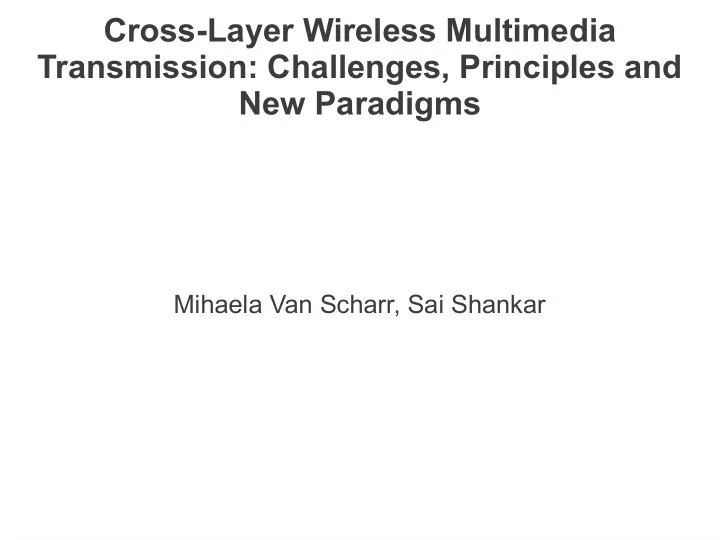

Cross-Layer Wireless Multimedia Transmission: Challenges, Principles and New Paradigms Mihaela Van Scharr, Sai Shankar
Overview of Presentation ● Multimedia transmission in wireless networks. ● Part 1: meeting QoS constraints ● Part 2: fairness and “coopetition”
Multimedia Transmission ● Quality of Service (QOS) constraints in multimedia: ● Can tolerate some errors / dropped packets ● Sensitive to delay ● High Bandwidth
Cross-layer Optimization Background ● Link adaptation ● Channel-aware scheduling ● Optimal power control ● Don't consider characteristics of multimedia. ● Redesign existing protocols?
Layers being considered ● Applications (APP) ● Medium Access Control (MAC) ● Physical Layer (PHY)
PART 1: meeting QoS constraints
Definitions ● denotes the number of PHY, MAC, APP adaptation and prediction strategies. ● Joint cross-layer strategy is defined as: ● denotes multimedia quality. ● = (SNR, contention) represents the instantaneous channel condition
Cross-Layer Optimization Problem ● Optimal strategy denoted as: with constraints: ● Many approaches to this optimization problem.
Cross-Layer Optimization Problem
Minimum required APP-layer packet length as a function of SNR R denotes MAC retry limit
Joint MAC/PHY Optimization ● Use received signal strength indicator (RSSI) via ACK to adapt modulation at PHY. ● Increase throughput. ● But this is not optimal for multimedia.
Joint MAC/PHY Optimization
Joint APP/MAC/PHY Optimization ● denote the base layer and enhancement layer rates at the APP. ● : MAC packet size. ● : modulation strategy at PHY.
Joint APP/MAC/PHY Optimization ● Optimal strategy becomes: with
Joint APP/MAC/PHY Optimization
Joint APP/MAC/PHY Optimization
PART 2: Fairness
Ideal Fair Scheduler Based on Generalized Processor Scheduler ● : amount of video flow from WSTA at time interval . ● : weight based on requirements. ● Optimal policy is
Proposed Idea: Time Scheduling ● : time allocated to video stream of during time interval . ● : weight based on requirements. ● Fairness policy becomes
Scenario 1: same cross-layer strategies for both WSTAs
Scenario 2: WSTA1 experiences more severe fading and interference
Scenario 3: WSTA1 located further away from access point
Multimedia Quality Fairness ● Use information at APP to partition streams into multiple sub flows. ● Enforce minimum quality constraint for all stations.
Multimedia Quality Fairness
Conclusions ● Traditional cross-layer paradigms need to be adapted for multimedia transmission. ● Cross-layer optimization problem is exhaustive to solve deterministically.
Questions?
Recommend
More recommend